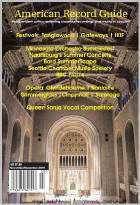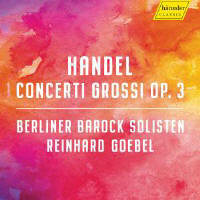Texte paru dans: / Appeared in: Hänsler Classics |
|
|
Outil de traduction ~ (Très approximatif) |
|
|
Reviewer: John
W. Barker It is no surprise that Handel’s two published sets of concerti grossi are so often recorded, for they are full of endless delight and beauty.
These two releases, both from Berlin ensembles, therefore confront a lot of competition. Scored for combinations of winds with strings, the Op. 3 set has had many enjoyable recordings. This one is a fine example of period-instrument presentation. Its chief competition right now is the recording made under Richard Egarr for Harmonia Mundi (907415). Egarr’s approach is a little more sprightly, with lots of individual touches. He uses about the same modest ensemble as heard here: 22 players for Goebel, 19 for Egarr. The latter fills out the definitive publication of Op.3 with a stray Sonata a 5 for strings. Goebel gives both scores for what has been called the set’s No. 4. A Concerto in F included as No. 4 in the first Walsh publication of Op. 3 has been identified as doubtful. In the second edition by Walsh of the set, approved by Handel, it was replaced by the more authentic F major Concerto now designated as “No. 4b”. Goebel includes both of these pieces, but Egarr gives only the authenticated 4b. Harmonia Mundi has also given us a dazzling Op. 6, under Andrew Manze (907228, 2CD: N/D 1998), and that is contested by the slightly more staid but really fine recording by the Avison Ensemble for Linn (362, 3CD: N/D 2010).
This new recording by Forck raises two particular considerations. First, it offers only half of the Op. 6: Nos. 1-6. In this respect, it echoes a parallel release by the Freiburg Baroque Orchestra under Gottfried von der Golz (Aparte 190: M/J 2019), which presents only 1-6 of the Opus 6 by Corelli. It is not clear either in that or in this new Handel release if the remainder will be taken up by these performers.
But Von der Golz’s Corelli release introduces another factor. Both the Corelli and Handel Opp. 6 were published as for strings and continuo only. But there is evidence that Corelli used at least some of these concertos as introductions to theatrical pieces and apparently employed some winds. Going on those hints, Von der Golz is rather adventurous in adding such parts in his Corelli recording. Now, we know that Handel used these Op. 6 concertos as fillers in his theatrical performances, and we have just scraps of evidence of the introduction of two oboes (with balancing bassoon) but just duplicating string parts. (Whereas the Op. 3 concertos are pastiches, taking music from earlier Handel stage works, the Op. 6 concertos, some borrowings from other composers aside, are pretty consistently original works by Handel.) Forck follows these clues and uses the winds in Nos. 1, 2, 5, and 6. As it happens, this “theatrical” life of these concertos has been explored in recordings already, first in individual concerto recordings but then in no less than three complete sets: Kevin Mallon (Naxos 555738), Jan Willem de Vriend (Challenge 72570), and Giovanni Antonioni (Oiseau-Lyre 478 0319), all 3CD, and all with period playing. I have compared them in some detail in S/O 2013. Forck uses the winds with some prominence, but I am just a little put off by his piercing violin sound. I prefer Antonioni’s among the full sets, but this kind of treatment remains an open field. For people who don’t want to bother with period playing of any kind, there are still the full modern-instrument recordings of both sets under the suave Neville Marriner, variously released but most conveniently combinedin a set from Decca (475 8673, 3CD: M/A 2008)—lovely, if you can find it. | |
|
|
|
|
Cliquez l'un ou l'autre
bouton pour découvrir bien d'autres critiques de CD |
|




